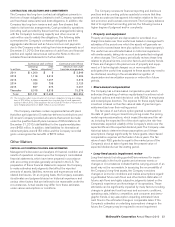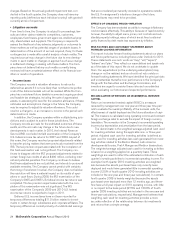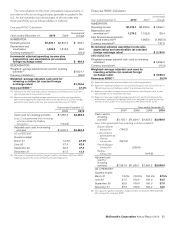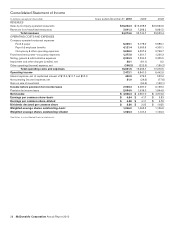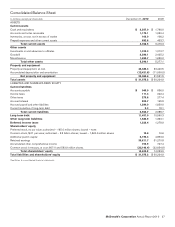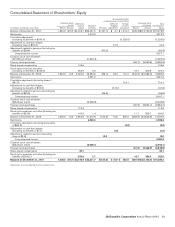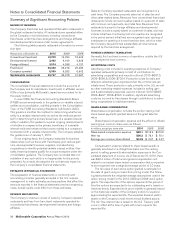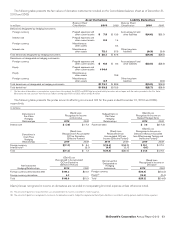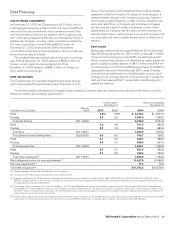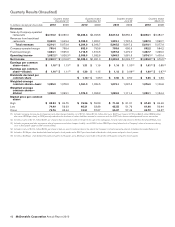McDonalds 2010 Annual Report Download - page 34
Download and view the complete annual report
Please find page 34 of the 2010 McDonalds annual report below. You can navigate through the pages in the report by either clicking on the pages listed below, or by using the keyword search tool below to find specific information within the annual report.
Certain of the Company’s derivatives are valued using various
pricing models or discounted cash flow analyses that incorporate
observable market parameters, such as interest rate yield curves,
option volatilities and currency rates, classified as Level 2 within
the valuation hierarchy. Derivative valuations incorporate credit
risk adjustments that are necessary to reflect the probability of
default by the counterparty or the Company.
• Certain Financial Assets and Liabilities Measured at
Fair Value
The following tables present financial assets and liabilities meas-
ured at fair value on a recurring basis by the valuation hierarchy
as defined in the fair value guidance:
December 31, 2010
In millions Level 1 Level 2 Level 3 Carrying
Value
Cash equivalents $722.5 $ 722.5
Investments 131.6* 131.6
Derivative receivables 104.4* $88.5 192.9
Total assets at fair
value $958.5 $ 88.5 $1,047.0
Derivative payables $ (8.4) $ (8.4)
Total liabilities at fair
value $ (8.4) $ (8.4)
December 31, 2009
In millions Level 1 Level 2 Level 3 Carrying
Value
Cash equivalents $455.8 $455.8
Investments 115.7* 115.7
Derivative receivables 79.6* $94.5 174.1
Total assets at fair
value $651.1 $ 94.5 $ 745.6
Derivative payables $ (7.0) $ (7.0)
Total liabilities at fair
value $ (7.0) $ (7.0)
* Includes long-term investments and derivatives that hedge market driven changes in
liabilities associated with the Company’s supplemental benefit plans.
• Non-Financial Assets and Liabilities Measured at Fair
Value on a Nonrecurring Basis
Certain assets and liabilities are measured at fair value on a
nonrecurring basis; that is, the assets and liabilities are not
measured at fair value on an ongoing basis, but are subject to fair
value adjustments in certain circumstances (e.g., when there is
evidence of impairment). At December 31, 2010, no material fair
value adjustments or fair value measurements were required for
non-financial assets or liabilities.
• Certain Financial Assets and Liabilities not Measured
at Fair Value
At December 31, 2010, the fair value of the Company’s debt
obligations was estimated at $12.5 billion, compared to a carry-
ing amount of $11.5 billion. This fair value was estimated using
various pricing models or discounted cash flow analyses that
incorporated quoted market prices and are similar to Level 2
inputs within the valuation hierarchy. The carrying amount for
both cash equivalents and notes receivable approximate fair
value.
FINANCIAL INSTRUMENTS AND HEDGING ACTIVITIES
The Company is exposed to global market risks, including the
effect of changes in interest rates and foreign currency fluctua-
tions. The Company uses foreign currency denominated debt and
derivative instruments to mitigate the impact of these changes.
The Company does not use derivatives with a level of complexity
or with a risk higher than the exposures to be hedged and does
not hold or issue derivatives for trading purposes.
The Company documents its risk management objective and
strategy for undertaking hedging transactions, as well as all rela-
tionships between hedging instruments and hedged items. The
Company’s derivatives that are designated as hedging instru-
ments consist mainly of interest rate exchange agreements,
forward foreign currency exchange agreements and foreign cur-
rency options. Interest rate exchange agreements are entered
into to manage the interest rate risk associated with the Compa-
ny’s fixed and floating-rate borrowings. Forward foreign currency
exchange agreements and foreign currency options are entered
into to mitigate the risk that forecasted foreign currency cash
flows (such as royalties denominated in foreign currencies) will
be adversely affected by changes in foreign currency exchange
rates. Certain foreign currency denominated debt is used, in part,
to protect the value of the Company’s investments in certain for-
eign subsidiaries and affiliates from changes in foreign currency
exchange rates.
The Company also enters into certain derivatives that are not
designated as hedging instruments. The Company has entered
into equity derivative contracts to hedge market-driven changes
in certain of its supplemental benefit plan liabilities. Changes in
the fair value of these derivatives are recorded in selling, gen-
eral & administrative expenses together with the changes in the
supplemental benefit plan liabilities. In addition, the Company
uses forward foreign currency exchange agreements and foreign
currency exchange agreements to mitigate the change in fair
value of certain foreign currency denominated assets and
liabilities. Since these derivatives are not designated as hedging
instruments, the changes in the fair value of these derivatives are
recognized immediately in nonoperating (income) expense
together with the currency gain or loss from the hedged balance
sheet position. A portion of the Company’s foreign currency
options (more fully described in the Cash Flow Hedging Strategy
section) are undesignated as hedging instruments as the under-
lying foreign currency royalties are earned.
All derivative instruments designated as hedging instruments
are classified as fair value, cash flow or net investment hedges.
All derivatives (including those not designated as hedging
instruments) are recognized on the Consolidated balance sheet
at fair value and classified based on the instruments’ maturity
date. Changes in the fair value measurements of the derivative
instruments are reflected as adjustments to other comprehensive
income (OCI) and/or current earnings.
32 McDonald’s Corporation Annual Report 2010



